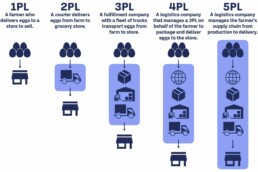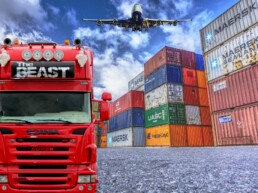Logistics Providers Explained
The majority of business owners have heard the phrase “3PL” or other “PL” terminology. What most people don’t realize is that there are many tiers of logistics providers, and their services vary based on the needs of your company.
In this article, you will learn the distinctions between logistics providers to help you determine which type is best for your company.

1PL – First-Party Logistics
A First-Party Logistic Provider is made up of two parties, the supplier and the retailer/customer. A 1PL logistics provider transports items from stock to shelves. In this type of relationship, the supplier manages their own inventory, storage, and delivery.
2PL – Second-Party Logistics
Second-Party Logistics Providers focus solely on the transportation sector of business. Examples of 2PLs include airlines, shipping lines, and hauling companies that operate the vehicles. 2PLs transport inventory between one or more legs of the fulfillment journey.
3PL – Third-Party Logistics
Third-Party Logistics is an industry term most are familiar with. For companies looking to outsource their entire logistics process, 3PLs are the answer. They are able to handle the management of receiving, inventory warehousing, packaging, and shipping services, letting e-commerce businesses focus on other important areas of their company. Some 3PL businesses offer additional logistics services known as value-added services. These include inventory management, kitting and assembly, and more.
According to Armstrong and Associates, 90% of Fortune 500 companies use a 3PL.
4PL – Fourth-Party Logistics
Fourth-Party Logistic Providers act as consultants. While their services are similar to a 3PL, they lack the physical means to move inventory through the supply chain themselves. Instead, a 4PL will contact and negotiate services between the necessary companies on your behalf.
5PL – Fifth-Party Logistics
A Fifth-Party Logistics Provider, or 5PL, is a consultant that operates at a level above a 4PL. Essentially, 5PLs serve as aggregators for 3PLs by bundling the needs of multiple 3PL businesses to secure better rates on services. When working with a 5PL, you can expect a fully integrated logistics solution that encompasses the entire supply chain from beginning to end. This is achieved through the coordination of multiple outsourced logistics providers, ensuring a seamless and efficient process.
The Sweet Spot
Similar to the story of Goldilocks and the Three Bears, supply chain providers are their own metaphorical bowls of porridge. Some are too cold, simple, and bland. Others are too hot, complex, and hard to understand. However, there is one porridge that comes at just the right temperature, provides just the right amount of support, and allows your e-commerce to successfully grow and scale. 3PLs are the sweet spot of supply chain service providers. With full control mixed with the support you need from fulfillment experts, you’re free to focus on more important aspects of your business while your fulfillment seemingly manages itself.
The Bottom Line
A 1PL partner is the simplest system and doesn’t require excessive integration or networking. Your business has full control over the supply chain process, however, your ability to scale will be limited and the risk of supply chain obstacles will increase.
A 2PL also uses a simpler system, but it does not offer as many logistics solutions as other supply chain providers.
Once your company is in a position to consider 3PL services, it’s time to transfer some aspects of your business over to the experts. These aspects are various parts of the fulfillment process that take the most time and precision, including but not limited to warehouse storage, inventory management, order processing, and order assembly. While these aspects are outsourced, your business still retains control and final say.
Beginner’s Guide to Third-Party Logistics (3PL)
The world of e-commerce is always changing, therefore understanding the roll of Third-Party Logistics is integral to keeping up. In light of this our beginner’s guide to third-party logistics (3PL) will delve into the essential aspects, offering insights into fulfillment services, warehousing, and much more.
Read More…
If you’re interested in outsourcing your entire supply chain process, a 4PL or 5PL are great options depending on the needs of your company. However, businesses that outsource with a 4PL or 5PL tend to have less control over their supply chain and final-say decisions. If you’re searching for a reliable 3PL partner, look no further. At our company, we own and operate dual warehousing facilities strategically located nationwide. Our multisite infrastructure enables us to efficiently distribute inventory nationwide while simultaneously reducing transit times and shipping costs.





